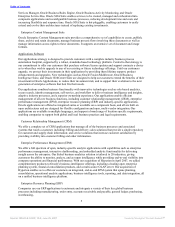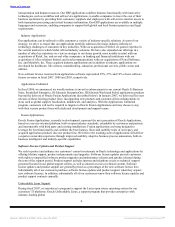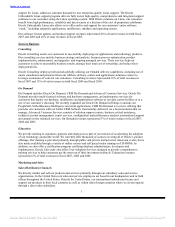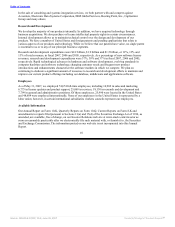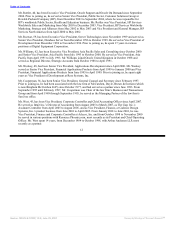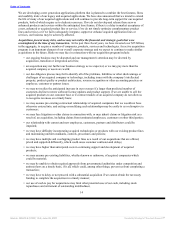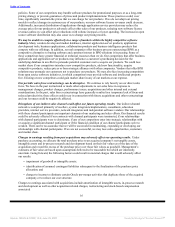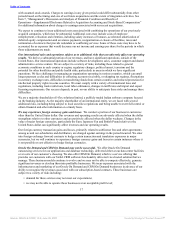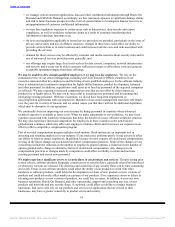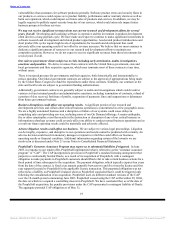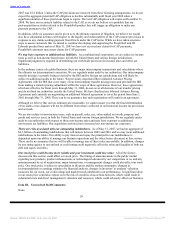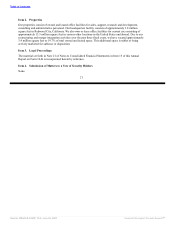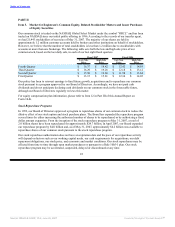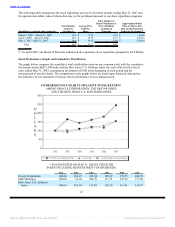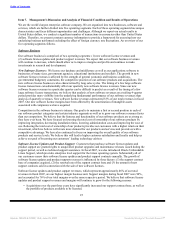Oracle 2006 Annual Report Download - page 19
Download and view the complete annual report
Please find page 19 of the 2006 Oracle annual report below. You can navigate through the pages in the report by either clicking on the pages listed below, or by using the keyword search tool below to find specific information within the annual report.
Table of Contents
• we may significantly increase our interest expense, leverage and debt service requirements if we incur
additional debt to pay for an acquisition; result of unforeseen difficulties in our integration activities;
• we may have legal and tax exposures or lose anticipated tax benefits as a result of unforeseen
difficulties in our integration activities;
• we may be unable to obtain timely approvals from, or may otherwise have certain limitations,
restrictions, penalties or other sanctions imposed on us by, worker councils or similar bodies under
applicable employment laws as a result of an acquisition, which could adversely affect our integration
plans in certain jurisdictions; and
• to the extent that we issue a significant amount of equity securities in connection with future
acquisitions, existing stockholders may be diluted and earnings per share may decrease.
The occurrence of any of these risks could have a material adverse effect on our business, results of
operations, financial condition or cash flows, particularly in the case of a larger acquisition or several
concurrent acquisitions.
We may not be able to protect our intellectual property rights. We rely on copyright, trademark, patent and
trade secret laws, confidentiality procedures, controls and contractual commitments to protect our intellectual
property rights. Despite our efforts, these protections may be limited. Unauthorized third parties may try to
copy or reverse engineer portions of our products or otherwise obtain and use our intellectual property. Any
patents owned by us may be invalidated, circumvented or challenged. Any of our pending or future patent
applications, whether or not being currently challenged, may not be issued with the scope of the claims we
seek, if at all. In addition, the laws of some countries do not provide the same level of protection of our
intellectual property rights as do the laws and courts of the United States. If we cannot protect our intellectual
property rights against unauthorized copying or use, or other misappropriation, we may not remain
competitive.
Third parties may claim infringement or misuse of intellectual property rights and/ or breach of license
agreement provisions. We periodically receive notices from others claiming infringement, or other misuse of
their intellectual property rights and/or breach of our agreements with them. We expect the number of such
claims will increase as the number of products and competitors in our industry segments grows, the
functionality of products overlap, the use and support of third-party code (including open source code)
becomes more prevalent in the software industry, and the volume of issued software patents continues to
increase. Responding to any such claim, regardless of its validity, could:
• be time-consuming, costly and/or result in litigation;
• divert management’s time and attention from developing our business;
• require us to pay monetary damages or enter into royalty and licensing agreements that we would not
normally find acceptable;
• require us to stop selling or to redesign certain of our products;
• require us to release source code to third parties, possibly under open source license terms;
• require us to satisfy indemnification obligations to our customers; or
• otherwise adversely affect our business, results of operations, financial condition or cash flows.
A patent infringement case is discussed under Note 21 in our Notes to Consolidated Financial Statements.
We may need to change our pricing models to compete successfully. The intensely competitive markets in
which we compete can put pressure on us to reduce our prices. If our competitors offer deep discounts on
certain products or services, we may need to lower prices or offer other favorable terms in order to compete
successfully. Any such changes would likely reduce margins and could adversely affect operating results. Our
software license updates and product support fees are generally priced as a percentage of our new license fees.
Our competitors may offer a lower percentage pricing on product updates and support, which could put
pressure on us to further discount our new license prices. Any broad-based change to our prices and pricing
policies could cause new software license and services revenues to decline or be delayed as our sales force
implements and our customers adjust to the new pricing
15
Source: ORACLE CORP, 10-K, June 29, 2007 Powered by Morningstar® Document Research℠


